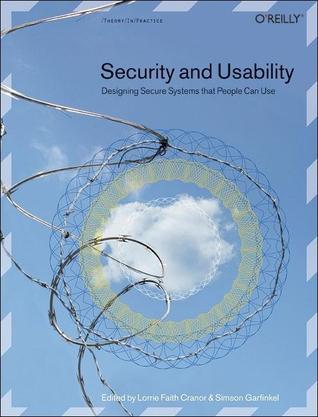What do you think?
Rate this book


738 pages, Paperback
First published January 1, 2005
1. Psychological Acceptability Revisited (Matt Bishop)The main lesson the articles try to promote is that it makes no sense to pit security features against usability; if a system´s users find its security features difficult to understand and hard to use, they will not be used or, at the very least, they will not be used correctly, defeating their purpose.
2. Usable Security (M. Angela Sasse, Ivan Flechais)
3. Design for Usability (Bruce Tognazzini)
4. Usability Design and Evaluation for Privacy and Security Solutions (Clare-Marie Karat, Carolyn Brodie, John Karat)
5. Designing Systems that People will Trust (Andrew S. Patrick, Pamela Briggs, Stephen Marsh)
6. Evaluating Authentication Mechanisms (Karen Renaud)Part Three is a rather mixed bag of six articles ranging from proposed schemes to fight phishing, to usable PKI to security administration tools to the problem of dealing with deleting mechanism that do not really delete stuff. I would recommend:
7. The Memorability and Security of Passwords (Jeff Yan, Alan Blackwell, Ross Anderson, Alasdair Grant)
8. Designing Authentication Systems with Challenge Questions (Mike Just)
9. Graphical Passwords (Fabian Monrose, Michael K. Reiter)
10. Usable Biometrics (Lynne Coventry)
13. Guidelines and Strategies for Secure Interaction Design (Ka-Ping Yee)A book like this would not be complete without touching on Privacy and Anonymity Systems. Part IV includes eight articles on this important topic. In this part of the book, a key weakness of the collection emerges: the tendency to study important issues in the context of particular and sometimes, experimental systems which have completely disappeared by now. Privacy is also an area of concern which has exploded in the last decade, which may contribute to my feeling this section of the book to be the one which most falls short. Thus, I would only recommend (and with reservations) the following articles:
14. Fighting Phishing at the User Interface (Robert Miller, Min Wu)
15. (A must read for anyone interested in computer forensics!) Sanitization and Usability (Simon Garfinkel)
18. Security Administration Tools and Practices (Eser Kandogan, Eben M. Haber)
22. Privacy Policies and Privacy Preferences (Lorrie Faith Cranor)I found the five article Part V on Commercializing Usability: The Vendor Perspective, the weakest, least interesting and most dated part of the book. Of course there is certain historical interest in reading about the irruption of Firefox;
24. Informed Consent by Design (Batya Friedman, Peyina Lin, Jessica K. Miller)
26. Anonymity Loves Company: Usability and the Network Effect (Roger Dingledine, Nick Mathewson)
28. Firefox and the Worry-Free Web (Blake Frost)and Microsoft´s rather tepid micro-reply;
29. Users and Trust: A Microsoft Case Study (Chris Nodder)but, I confess that I found the article on IBM Lotus Notes confusing and singularly unhelpful, and the articles on ZoneAlarm and Groove (an interesting idea which probably peaked in 2005 just as Microsoft acquired it) only mildly interesting, perhaps because one feels, perhaps unjustly, that they are vendor biased and the book fails to provide enough context against which to evaluate them.
32. Users are not the enemy (Anne Adams, M. Angela Sasse)
33. Usability and Privacy: A Study of KaZaA P2P File Sharing (Nathaniel S. Good, Aaron Krekelberg)
34. Why Johnny can´t Encrypt (Alma Whitten, J. D. Tygar) - a must read...
The editors and the publisher would be well advised to put together an updated version of this book -the world-wide explosion in security-related incidents and the outcry for more secure systems imply that security and its relation to usability is at the very least as topical and crucial now as it was ten years ago.